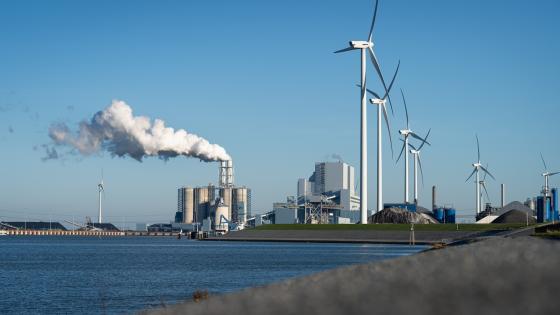Unit Energy Cost: Concept and methodology
The cost of energy is a significant determinant of competitiveness for the manufacturing industry. To provide a comprehensive assessment of the role of energy in determining industrial competitiveness, intensity of use and price should be looked at in combination. Similarly to Unit Labour Cost, the Unit Energy Cost (UEC) indicator developed in our report1 measures the energy cost per unit of value added in a given sector (or in an aggregation thereof).2
The analysis was conducted on the total manufacturing sector and 14 subsectors using input-output tables available in the World Input Output Database (WIOD). Such tables enable us to observe the actual costs incurred to purchase energy inputs, and their respective quantities. Four categories of energy inputs are covered:
- coal and lignite;
- peat, crude petroleum and natural gas
- coke, refined petroleum and nuclear fuels
- electrical energy, gas, steam and hot water.
The UEC is calculated on the basis of direct energy costs, meaning the costs incurred when purchasing energy inputs, including feedstocks.
How has the EU manufacturing sector performed over past decades?
Real Unit Energy Costs (RUECs)3 have increased in both the EU and the rest of the world since the mid-1990s. The increase has been broadly similar in most major developed economies (EU, US, and Japan), at around 5-6 % per year over the period, while it has been slightly lower in emerging economies such as China and Russia (3 % per year).
Compared to the US, Japan, and the BRIC economies, the EU manufacturing industry had one of the lowest RUECs in terms of value-added after Japan in 2011. The picture changes when the refining sector is taken out of the computation of RUEC. When this is done, the US performs slightly better than the EU and Japan. This highlights the importance of the US refining sector when assessing the energy cost competitiveness of the US manufacturing sector.
Figure 1.

Source: European Commission, based on WIOD database.
The decomposition of Unit Energy Costs: Eeal energy prices and energy intensity
Unit Energy Costs can be decomposed into real energy prices and energy intensity (the reciprocal of energy productivity), which helps shed light on the drivers of energy cost competitiveness. Real energy prices are highest in Japan and the EU. However, these regions have the lowest levels of energy intensity, while the US and China show considerably higher levels. As a result the EU and Japanese manufacturing sectors have been able to maintain their energy cost competitiveness through energy intensity performance.
The picture is more varied for manufacturing sub-sectors, in particular for those with a higher share of energy in production costs. In the EU the RUEC of sectors such as coke and refined petrol, chemicals, non-metallic minerals, metals, and rubber and plastics is higher than in the US and in some cases also higher than in Japan.
Is the good performance of the EU’s manufacturing sector due to a restructuring effect?
The analysis also assesses the extent to which the evolution of Unit Energy Costs in the manufacturing sector has been driven by (i) the evolution of energy costs within sectors and/or by (ii) a restructuring between sectors. When faced with high energy prices, the economy may respond by reallocating resources from high to low energy-intensive sectors. This would lead to a decline in the weight of high energy cost industries in the economy and would tend to lower the overall energy-intensity of the economy as a whole. To investigate the effects of these two factors, a shift share analysis was carried out. Changes in the RUEC of total manufacturing was broken down into a change in the RUECs of subsectors (‘energy cost effect’) and a change in the shares of subsectors in total manufacturing (‘restructuring effect’), along with a dynamic interaction component of the two effects.
The bulk of RUEC growth in the EU27, Japan and China was driven by the ‘energy cost effect’; i.e. energy cost increases within sectors (Graph I.1.6). There is no evidence of a significant ‘restructuring effect’ in the EU during this long period. In contrast, RUEC growth in the US was dominated by the static ‘restructuring effect’, i.e. by an increase in the weight of high energy cost industries – particularly of the coke and refined petrol industry. Overall these developments may signal an increased specialisation of US manufacturing in high energy cost production with respect to other economies.
The ‘restructuring effect’ observed with the full data set essentially disappears once the refining sector is excluded. This is most evident in the US, where the large positive ‘restructuring effect’ shown in the period 1995-2011 is no longer observable once the refining sector is excluded. This further demonstrates the increased relevance of this sector in the US economy, which went from 3 % of total manufacturing GVA to 10 % over the 15 years.
Figure 2.

The picture changes when the shift share analysis is decomposed into shorter periods. Over the period 2005-2011 – which includes the surge in the exploitation of shale gas in the US, as well as the peak in oil prices of 2008 and subsequent fall in 2009 – a significant adjustment and restructuring on a global scale took place. During this time, REUCs in the EU rose only moderately, as the limited negative restructuring effect away from high energy cost sectors was offset by a pure ‘energy cost effect,’ which was substantially higher than in the other economies. In contrast, the RUEC growth in the US is actually negative. This is probably due to the substantial reduction in electricity and gas prices which was made possible by the exploitation of shale gas.
Conclusions
The results indicate that the EU manufacturing sector has enjoyed some of the lowest Real Unit Energy Costs since the mid-1990s, in line with that of the US and Japan. This means that to obtain one USD of value added, they have spent a lower amount of money on energy sources than either Russia or China.
This relatively good performance has mostly been driven by improvements in the energy intensity of the EU manufacturing sector, which have helped to offset the increase in real energy prices. EU manufacturers have steadily improved their energy intensity performance, converging towards Japanese levels. The US and China have been catching up but the difference in absolute levels remain substantial.
The RUEC evolution over the period has been mostly explained by the ‘energy cost effect’ in the EU. Our shift share analysis also shows that a ‘restructuring effect’ did take place, especially within the US economy. This has been driven essentially by the refining sector which tripled its relative importance in the value added of the manufacturing sector. In the EU, a slightly negative ‘restructuring effect’ can be observed between 2005-2011, signalling a partial move away from energy intensive industries. However, these developments seem also to be driven by the refining sector, since the restructuring effect disappears once the sector is taken out of the calculation.
In the future, the room for improving energy intensity in the EU will be more limited and other parts of the world will likely catch up. To preserve the EU’s competitive edge, it is crucial to continue to promote energy efficiency and ensure that energy prices do not rise too much.
Authors' note: A longer version of this paper was published in Energy Economic Developments in Europe, European Economy, 1/2014, 22.01.2014, SWD(2014)19.
The opinions expressed herein are those of the authors and do not necessarily reflect the views of the European Commission. We thank Anne Bucher and Peter Koh for their comments.
Footnotes
1 European Economy (2014).
2 In our report, we choose to present the unit energy costs as a percentage of value added. Unit energy costs as a percentage of gross output are also presented for comparison. .
3 RUECs focus on the true energy effects in energy cost development, i.e. RUECs are cleared of nominal macroeconomic effects such as inflation and nominal exchange rate fluctuations.







